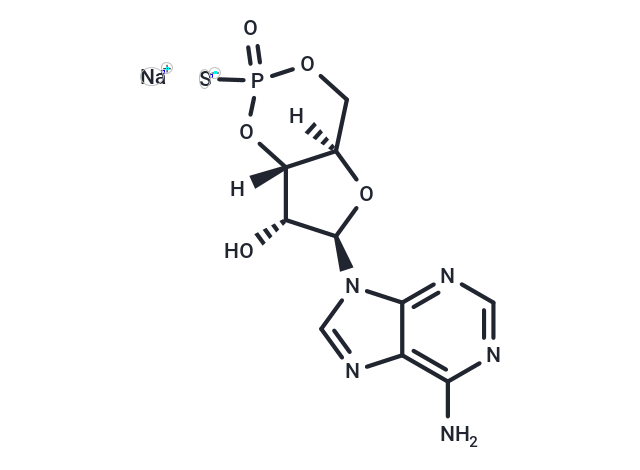Shopping Cart
Remove All Your shopping cart is currently empty
Your shopping cart is currently empty
Rp-cAMPS sodium is a phosphorothioate analog of cAMP, a protein kinase A inhibitor and a membrane-permeable cAMP antagonist that inhibits cAMP-dependent protein kinases by blocking cAMP-induced conformational transitions, and can be used in the study of cardiovascular diseases.

| Pack Size | Price | USA Warehouse | Global Warehouse | Quantity |
|---|---|---|---|---|
| 1 mg | $299 | - | In Stock |
| Description | Rp-cAMPS sodium is a phosphorothioate analog of cAMP, a protein kinase A inhibitor and a membrane-permeable cAMP antagonist that inhibits cAMP-dependent protein kinases by blocking cAMP-induced conformational transitions, and can be used in the study of cardiovascular diseases. |
| Targets&IC50 | PKA I:6.05 µM (Ki), PKA II:9.75 µM (Ki) |
| In vitro | METHODS: To measure the inhibitory effect of Rp-cAMPS sodium on purified type II cAMP-dependent protein kinase, different concentrations of Rp-cAMPS sodium were added, and their impact on cAMP-induced phosphotransferase activity was observed. RESULTS: Rp-cAMPS sodium binds to cAMP but does not cause enzyme dissociation, thereby inhibiting the activity of the phosphotransferase[2]. |
| In vivo | METHODS: To investigate the effect of Rp-cAMPS sodium on synaptic transmission in a rat arthritis model, particularly its modulation of PB-CeLC and BLA-CelC synapses, EPSCs were evoked by stimulating the PB-CeLC and BLA-CelC synapses, and the changes before and after treatment were compared. RESULTS: Treatment with Rp-cAMPS sodium (10 μM, 15 minutes) significantly reduced the evoked single-synaptic EPSCs at the PB-CeLC and BLA-CelC synapses [2]. |
| Molecular Weight | 367.25 |
| Formula | C10H11N5NaO5PS |
| Cas No. | 142439-94-9 |
| Smiles | O[C@H]1[C@@H](O[C@@]2([H])[C@@]1([H])OP([S-])(OC2)=O)N3C4=NC=NC(N)=C4N=C3.[Na+] |
| Storage | store at low temperature,keep away from direct sunlight | Powder: -20°C for 3 years | In solvent: -80°C for 1 year | Shipping with blue ice/Shipping at ambient temperature. | |||||||||||||||||||||||||||||||||||
| Solubility Information | H2O: 80 mg/mL (217.84 mM), Sonication is recommended. | |||||||||||||||||||||||||||||||||||
Solution Preparation Table | ||||||||||||||||||||||||||||||||||||
H2O
| ||||||||||||||||||||||||||||||||||||
| Size | Quantity | Unit Price | Amount | Operation |
|---|

Copyright © 2015-2026 TargetMol Chemicals Inc. All Rights Reserved.